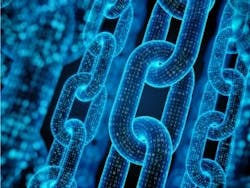Why Energy Blockchain Intrigues Big Players Like Siemens
Not so long ago energy blockchain technology had the futuristic feel of flying cars or colonies on Mars. But that has changed in recent months as credible players step in to test the transaction platform.
By Sashkin/Shutterstock
Among them is energy giant Siemens, which formed a partnership in November with a startup, LO3 Energy, to figure out how to make energy blockchain work for a Brooklyn microgrid – and demonstrate it for the rest of the world.
Microgrid Knowledge recently interviewed Michael Carlson, president of Siemens Digital Grid US, for insight into why Siemens — and now a lot of others in the power industry – are intrigued by energy blockchain.
Energy blockchain opens the possibility of electric efficiencies that the power industry has dreamed of for years, a chance to let the household become a real part of the energy market, both a buyer and seller of electricity right down to the kilowatts used by the refrigerator or pool pump.
Learn more about microgrids from thought leader Michael Carlson, president of Siemens Digital Grid US, at Microgrid 2017, Nov. 6-8 in Boston.
This is a big deal because the residential sector has been something of a ‘dumb’ black box when it comes to energy economics. Most households are not exposed to true electricity market prices. And even if they have some exposure, no automated way exists for them to take advantage of the information. The masses cannot buy and sell electricity minute-by-minute to get the best market deal – or even bypass the wholesale market and sell directly to each other.
Michael Carlson, president of Siemens Digital Grid US
“In the current constraint of everything — consumer practices, technology, the physical nature of the grid — there is never ultimate efficiency attained,” Carlson said.
Today, power is produced by large generators and sold in big blocks – megawatts and gigawatts to serve the generalized needs of large populations. Grid operators track and settle the transactions in vast rooms of highly trained staff using sophisticated software. Trying to insert small household transactions on the platforms would be a logistical nightmare.
This creates a “real barrier to entry” for the smallest producers and consumers (prosumers.) “Nobody wants to track pennies of transactions thousands of millions of times. But if blockchain creates that behind-the-scene back office reconciliation for millions of participants and millions and millions of transactions, all-of-a-sudden you have a new dynamic and opportunity,” he said.
In its ultimate vision, energy blockchain offers a platform for household-to-household, or ‘peer- to-peer’, transactions in real time. On a hot summer day, my solar panel sells its excess power to you because you need it for your air conditioner. It is an efficient match – I have a surplus, you have a deficit. Energy blockchain would allow such micro matches millions of times over among households. And the transactions would occur without you or I doing much of anything.
This achieves the “next generation of efficiency,” Carlson said, where power production and consumption become closely attuned on the micro level.
But realizing the ultimate market vision of blockchain remains years away. Many complexities have yet to be solved. Siemens and LO3 are taking first steps with a microgrid being developed in Brooklyn’s Boerum Hill, Gowanus and Park Slope neighborhoods. The microgrid offers a way to test the technology “and then let market forces start to shape the opportunities,” he said
“…all-of-a-sudden you have a new dynamic and opportunity” — Michael Carlson, Siemens
The project integrates Siemens microgrid controller with LO3’s energy market technology. Siemens’ advanced microgrid controller manages the physical energy assets in the system and LO3’s software handles the market side.
At this point, the team has vetted the technology from an architectural perspective. A lot of work lies ahead in developing a business model. And technology aside, the project team has the human side to consider; it must test and validate the system when it’s put in front of the prosumer, Carlson said.
“We can now aggregate the generating devices, we can aggregate the demand, and we can start interacting. We’re going to aggregate at the highest level of the community and then start to build that into iteratively more and more discrete and detailed transactions,” he said.
What energy blockchain means to utilities
In a world where, neighbors and communities can trade power, is there a need for a centralized wholesale grid? Some argue energy blockchain marks the start of a complete decentralization.
But Carlson doesn’t see it that way. He envisions a grid that marries large power plants, and their economies of scale, with distributed energy.
“My personal view is that in fact they would start to leverage each other — probably not so much the prosumer leveraging the wholesale market, but the wholesale market having an optic into what the prosumer is doing at a very micro level and optimizing around that,” he said.
That may be part of the reason blockchain is piquing utility interest and becoming a topic of discussion in industry conferences. Austria’s largest regional utility, Wien Energie, is working on an energy blockchain pilot program with the hope of commercializing the technology. Meanwhile, Siemens has been approached by about half a dozen utilities curious about the Brooklyn project.
Some utilities who haven’t “changed their spots” may feel threatened, he said, but a growing number are pursuing innovation, so are intrigued. “For the industry, it’s a positive. It’s going to open up another level of opportunity for efficiency and extension that doesn’t exist today.”
Read more about advanced microgrid controls and markets by downloading the free guide, “How Microgrids Can Achieve Maximum Return on Investment (ROI): The Role of the Advanced Microgrid Controller.”
[clickToTweet tweet=”Why Energy #Blockchain Intrigues Big Players Like Siemens” quote=”Why Energy Blockchain Intrigues Big Players Like Siemens”]
About the Author
Elisa Wood
Editor-in-Chief
Elisa Wood is the editor and founder of EnergyChangemakers.com. She is co-founder and former editor of Microgrid Knowledge.
